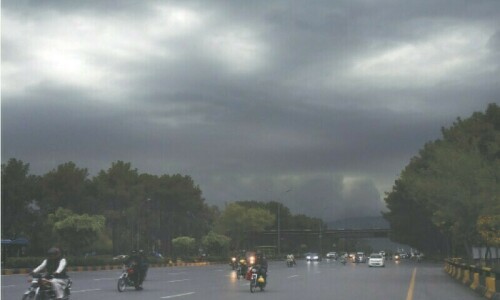HYDERABAD: Hyderabad, with a rich legacy of observing religious days, Muharram or Eid Miladun Nabi, in an exemplary peaceful and harmonious manner even during 80s and 90s when the city was divided along ethnic lines, is known for its historic Pir(s), Sindhi word for Imambargah, most of which were founded by Talpur rulers.
The many Pirs, which compete with each other during Muharram in embellishing alams, tazias and zuljanahs and bringing out processions, have become identity of Hyderabad, which still witnesses some of the oldest majalis.
“When it comes to observance of Muharram, Talpurs come to mind. They had promoted azadari with so much religious zeal that Mirs and azadari became synonymous,” says Mirza Kazim, a former custodian of Qadam Gah, who remained attached with the shrine for around a decade.
Mir Haider Talpur, a descendant of Talpur family, recalls that of the 11 of their elders interned by the British in India, only four survived. “They returned to Sindh in 1863,” says Mir Haider, who lives in his historic haveli in Tando Mir Noor Mohammad currently known as Latifabad unit-4.
The haveli houses around 160-year-old tazia. “Our elders had this tazia built perhaps around 1866-67. Mirzas of Tando Agha have been reciting marsiyas (elegies) in the courtyard of our haveli for decades and the ritual lives on even this day,” he says.
Likewise, Mirza Kazim’s forefathers had come from Georgia and settled in Hyderabad’s Tando Thoro area, the oldest settlement, in early 19th century. The area was later inhabited by families who had migrated from India after partition. A large part of the area later came to be known as Paretabad.
Kazim informs: “Before Pakistan’s inception, majlis for every day was pre-scheduled because we had a small population here”. But with passage of time more venues for majalis emerged. “Some of those majalis held on 5th, 6th, 8th and 9th of Muharram are still held in Tando Thoro and Tando Jehania,” reminisces Kazim.
“Tando Thoro’s Imambargah has lately been renovated with its new facade replicating the shrine of Imam Raza,” he adds.
“Books and literature inform us Mir saheban used to be invited to gatherings [mahfils] even by people professing faith other than Shia. The hosts would feel honoured to have Talpurs among them for gracing the occasions of fixing of alams in Imambargahs,” says Kazim.
While several Pirs (the word also refers to mourning processions) are staged and Imambargahs hold majalis, some are noteworthy for being identity of Hyderabad. Qadam Gah Maula Ali, however, tops the list.
Others are Mehfil-e-Hussaini off Station Road where ashra of majlis (majalis held during the first ten days of Muharram) is held on main Station Road. It is managed by Khoja community. Tando Agha’s Imambargah Anjuman Safeena-e-Hussaini, Imambargah Shah-e-Najaf Tando Jehania, Civil Lines and Karbala Dadan Shah are also on the list.
All major events during Muharram’s ashra (first ten days of the month) are connected with these places like the 7th Muharram’s Jamaiytan jo Pir emanating from Tando Agha and staged under the aegis of Anjuman Safeena-e-Hussaini. It is high point of observance insofar as the 7th Muharram is concerned with participation of a considerable number of people.
“The 8th Muharram’s ‘aag ka matam’ used to be staged in Tando Thoro in past but then it was shifted to Tando Jehania following an unpleasant incident involving Hazara community 50 years back,” recalls Kazim.
Syed Moazzam Jehania agrees with Kazim that this mode of mourning used to be staged in Tando Thoro before its relocation to his village in Tando Jehania. “Muharram 2024 will witness the 52nd proceedings of this mourning on July 15,” recalls, Moazzam, a descendant of Fateh Deen Shah.
Mehfil-e-Hussaini was founded by Asna-Ashari Khoja community’s men and Habib Jamal is one of them. Late Jamal’s son Turab Ali Khoja is looking after Mehfil-e-Hussaini.
“My father and other elders had founded it in a small place located in Resham Gali in 1948 after our elders migrated to Pakistan from India. Then it started working in present premises in 1967,” he recalls.
Tando Jehania located in Defence area where mourners perform angaro par matam (self-flagellation on live embers) on 8th of Muharram in the village named after Fateh Deen Shah Jehania and located in the limits of Cantonment Board Hyderabad.
All big or small processions which were part of Ashura’s central procession end in Karbala Dadan Shah, another old venue situated on the Mohammad Ali Johar road where Syed Fateh Deen is buried.
Published in Dawn, July 16th, 2024














































Dear visitor, the comments section is undergoing an overhaul and will return soon.